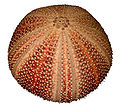
Tube feet
Encyclopedia
Tube feet are the many small tubular projections found most famously on the oral face of a sea star
's arms, but are characteristic of the water vascular system
of the echinoderm
phylum which also includes sea urchin
s, sand dollar
s and sea cucumbers and many other sea creatures.
Tube feet function in locomotion, feeding and respiration. The tube feet in a sea star are arranged in grooves along the arms. They operate through hydraulic pressure
. They are used to pass food to the oral mouth at the center, and can attach to surfaces. A sea star that is overturned simply turns one arm over and attaches it to a solid surface, and levers itself the right way up.
Tube feet allow these different types of animals to stick to the ocean floor and move very slowly.
Tube feet consist of two parts: ampulla and podia. Ampulla contain both circular muscles and longitudinal muscle, whereas the podia contain the latter only. Thus the podia use suction to attach to the substratum.

Sea star
Starfish or sea stars are echinoderms belonging to the class Asteroidea. The names "starfish" and "sea star" essentially refer to members of the class Asteroidea...
's arms, but are characteristic of the water vascular system
Water vascular system
The water vascular system is a hydraulic system used by echinoderms, such as sea stars and sea urchins, for locomotion, food and waste transportation, and respiration. The system is composed of canals connecting numerous tube feet...
of the echinoderm
Echinoderm
Echinoderms are a phylum of marine animals. Echinoderms are found at every ocean depth, from the intertidal zone to the abyssal zone....
phylum which also includes sea urchin
Sea urchin
Sea urchins or urchins are small, spiny, globular animals which, with their close kin, such as sand dollars, constitute the class Echinoidea of the echinoderm phylum. They inhabit all oceans. Their shell, or "test", is round and spiny, typically from across. Common colors include black and dull...
s, sand dollar
Sand dollar
The term Sand dollar refers to species of extremely flattened, burrowing echinoids belonging to the order Clypeasteroida. Some species within the order, not quite as flat, are known as sea biscuits...
s and sea cucumbers and many other sea creatures.
Tube feet function in locomotion, feeding and respiration. The tube feet in a sea star are arranged in grooves along the arms. They operate through hydraulic pressure
Hydraulics
Hydraulics is a topic in applied science and engineering dealing with the mechanical properties of liquids. Fluid mechanics provides the theoretical foundation for hydraulics, which focuses on the engineering uses of fluid properties. In fluid power, hydraulics is used for the generation, control,...
. They are used to pass food to the oral mouth at the center, and can attach to surfaces. A sea star that is overturned simply turns one arm over and attaches it to a solid surface, and levers itself the right way up.
Tube feet allow these different types of animals to stick to the ocean floor and move very slowly.
Tube feet consist of two parts: ampulla and podia. Ampulla contain both circular muscles and longitudinal muscle, whereas the podia contain the latter only. Thus the podia use suction to attach to the substratum.


